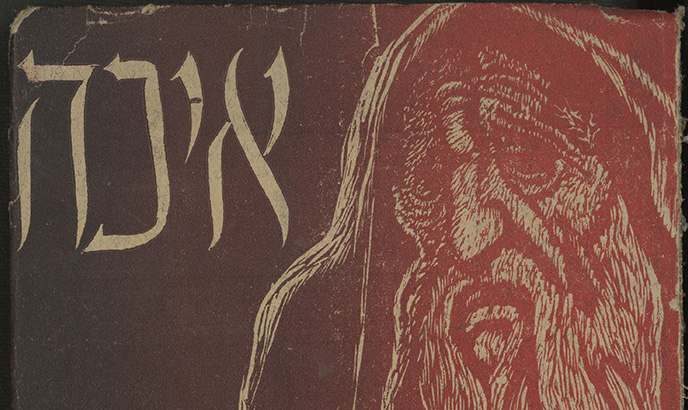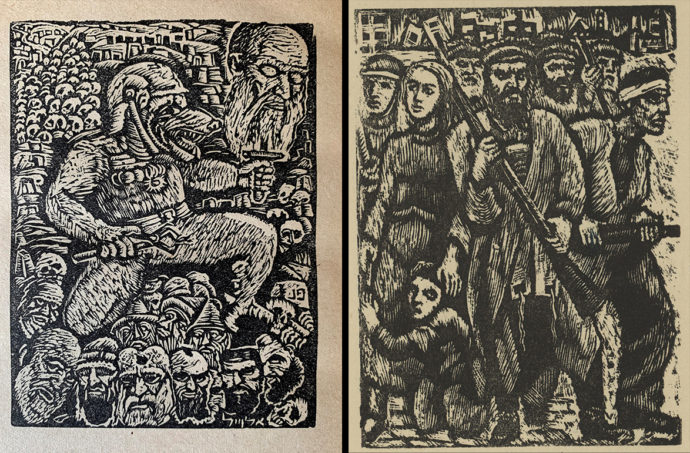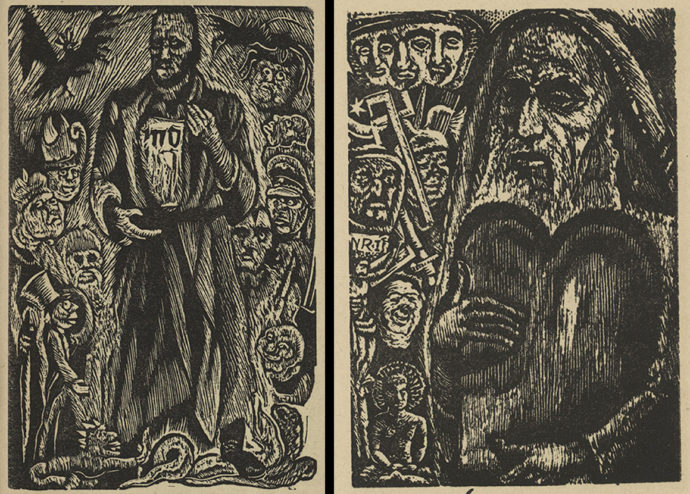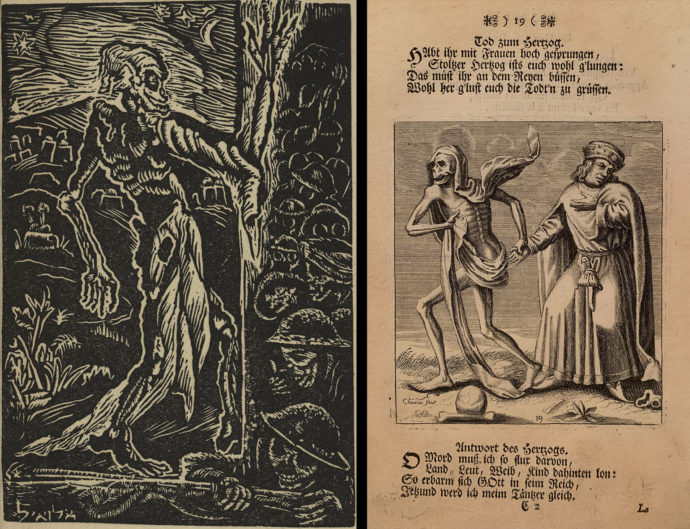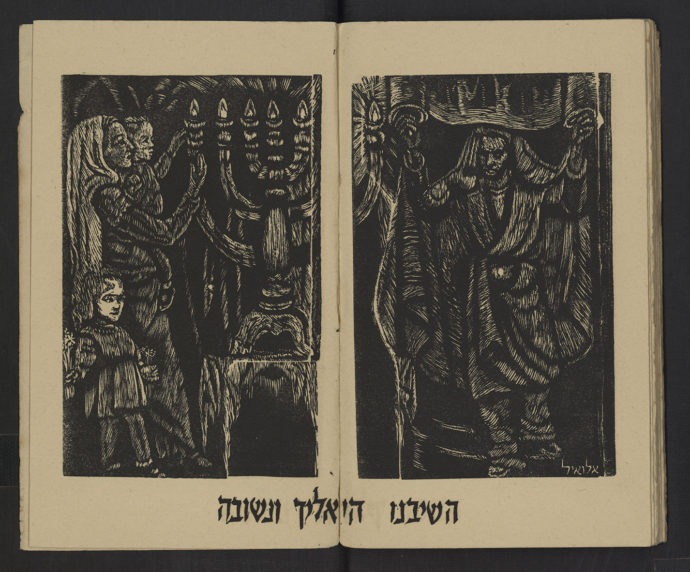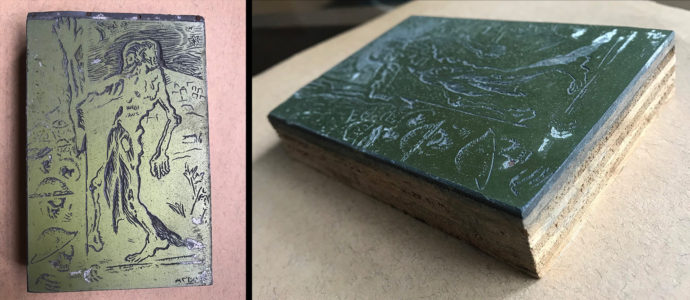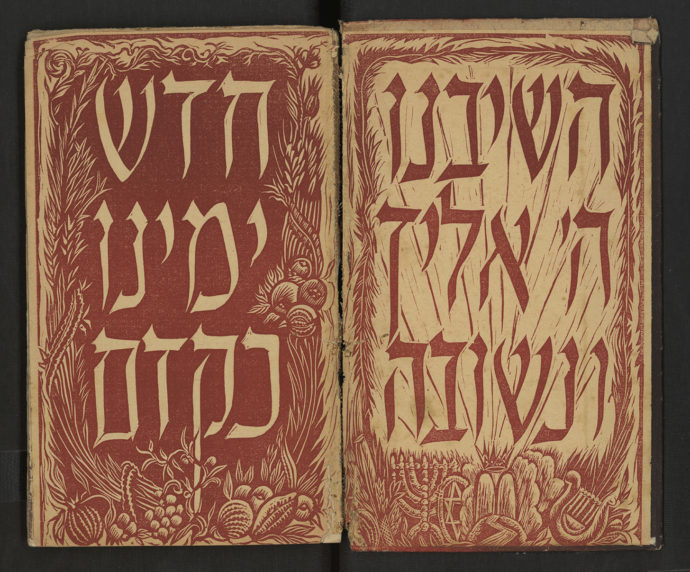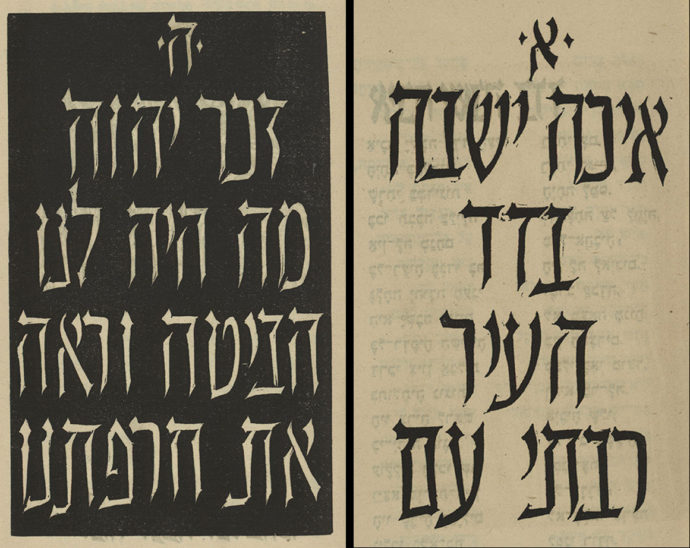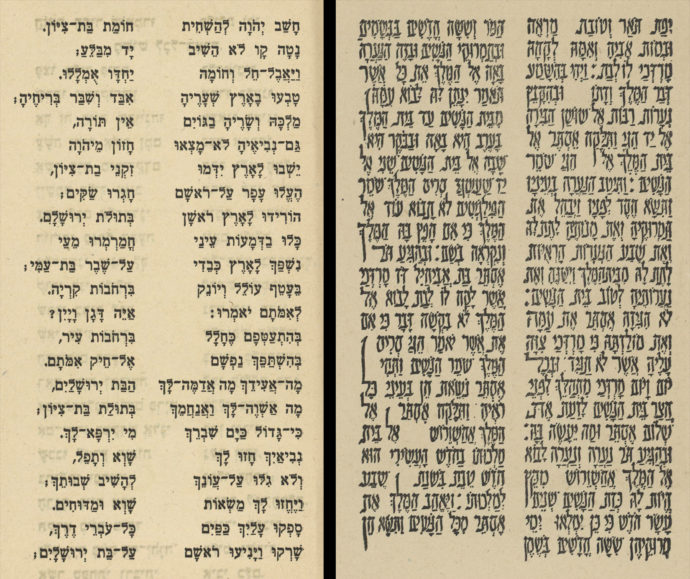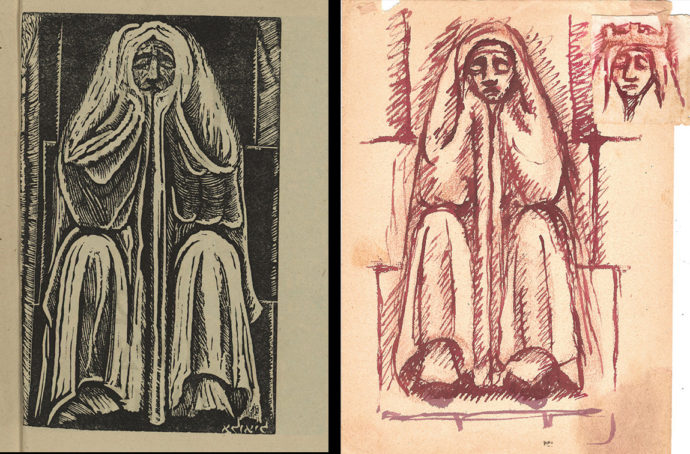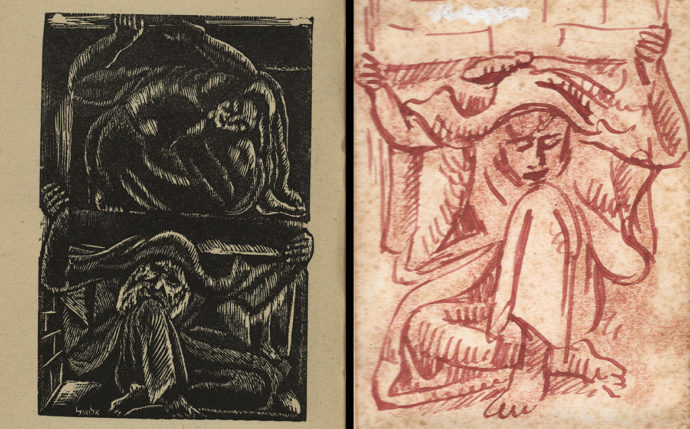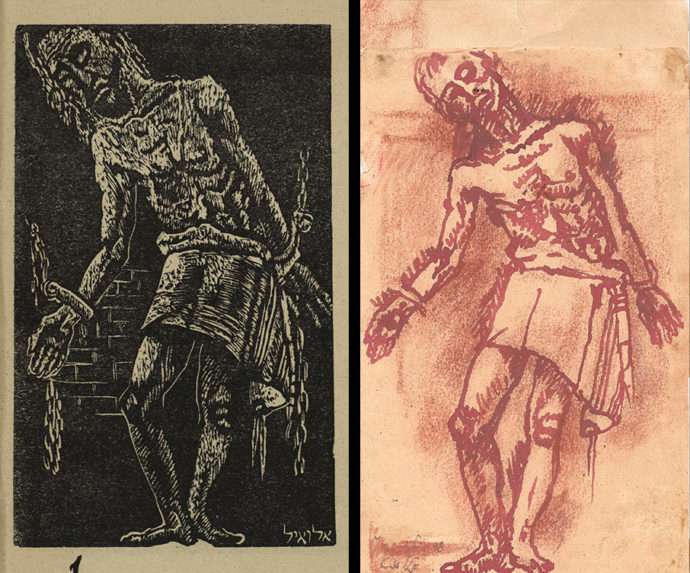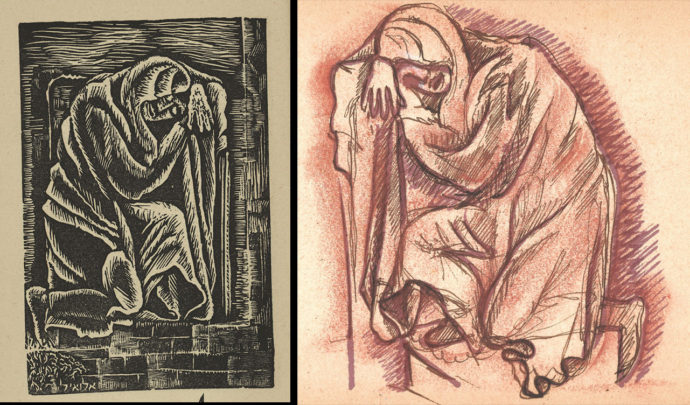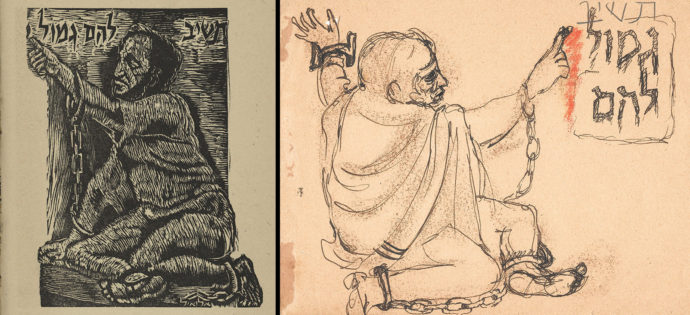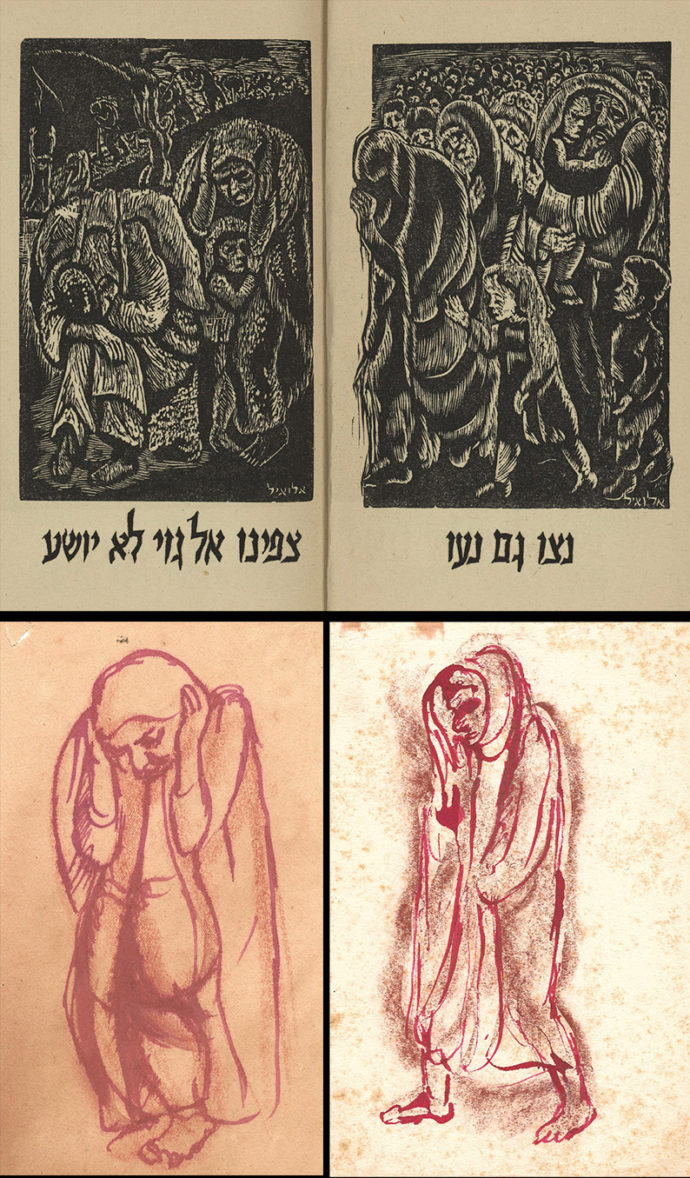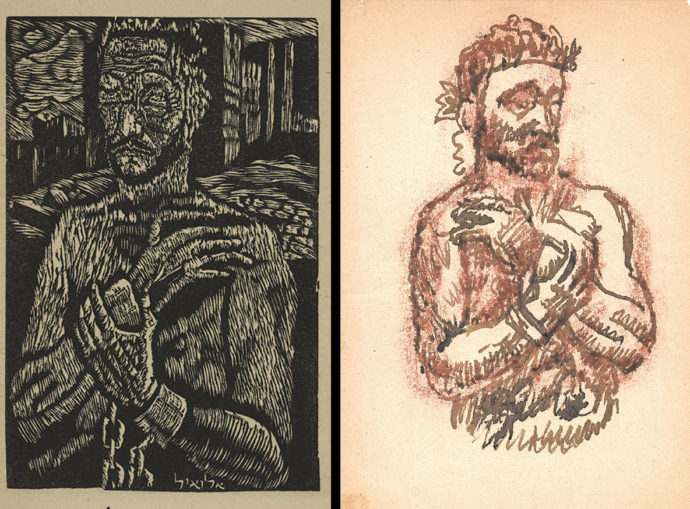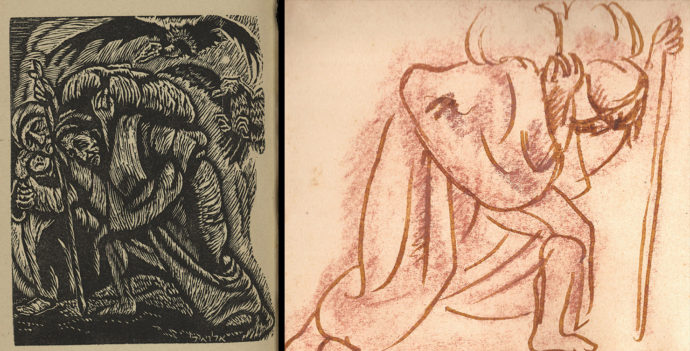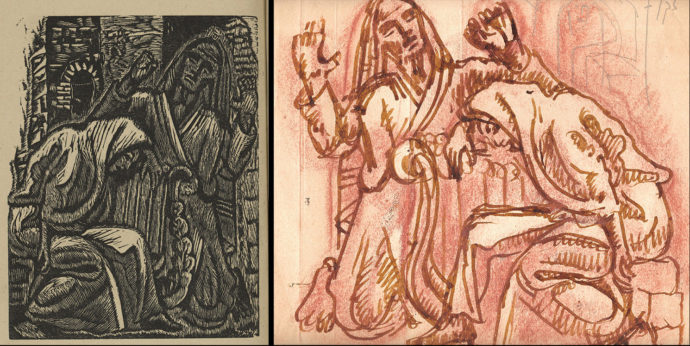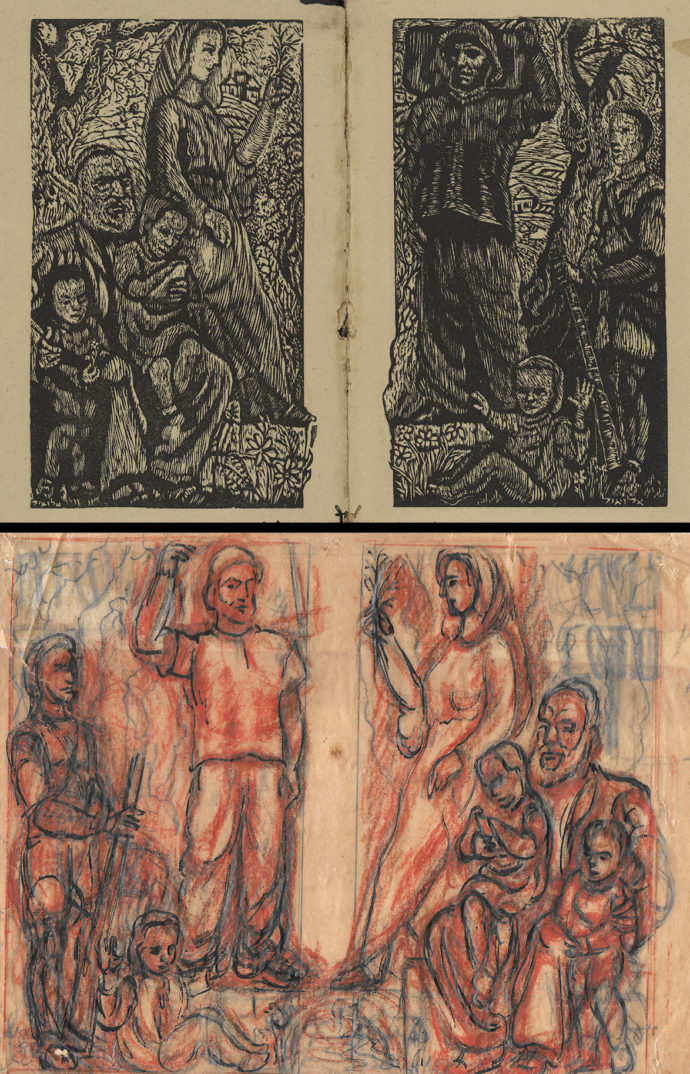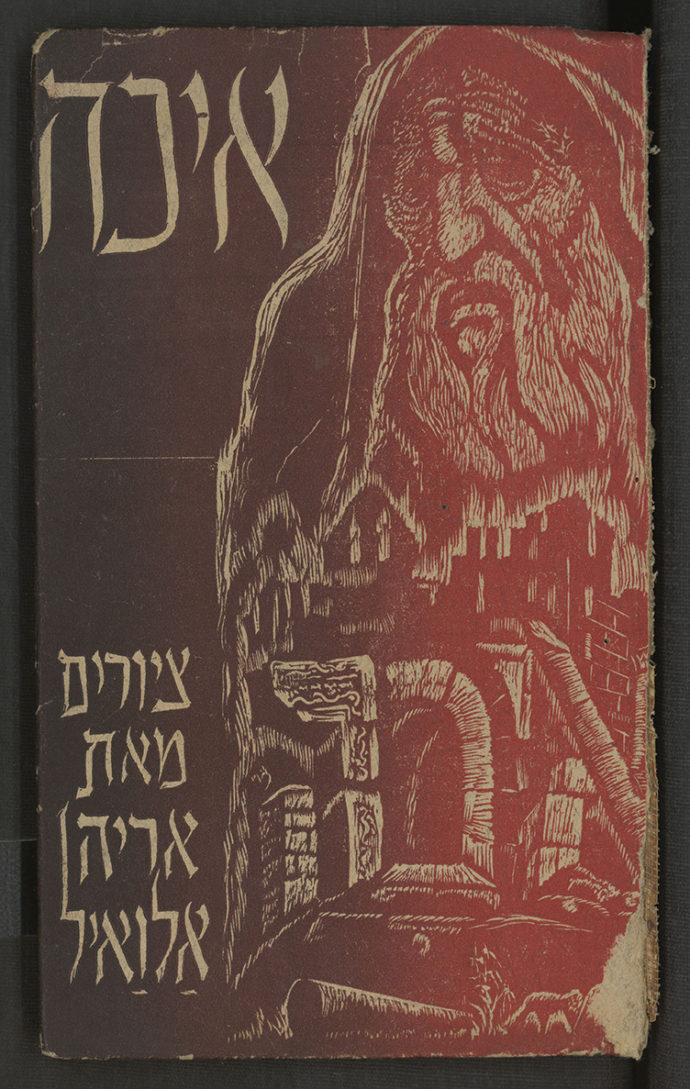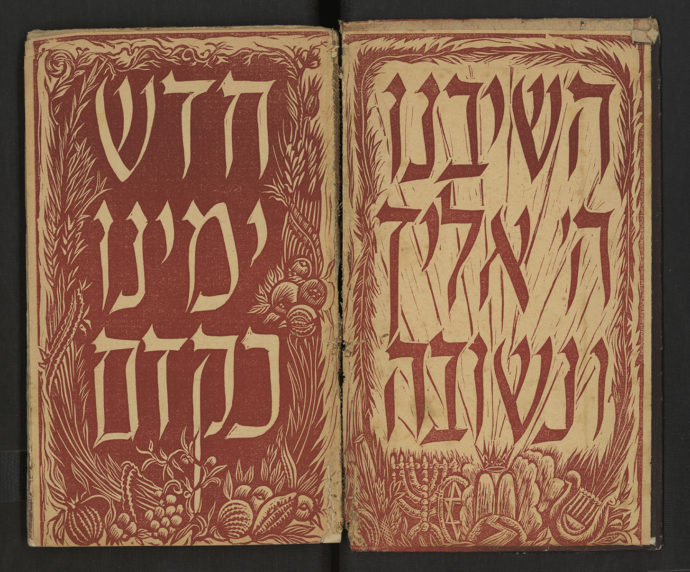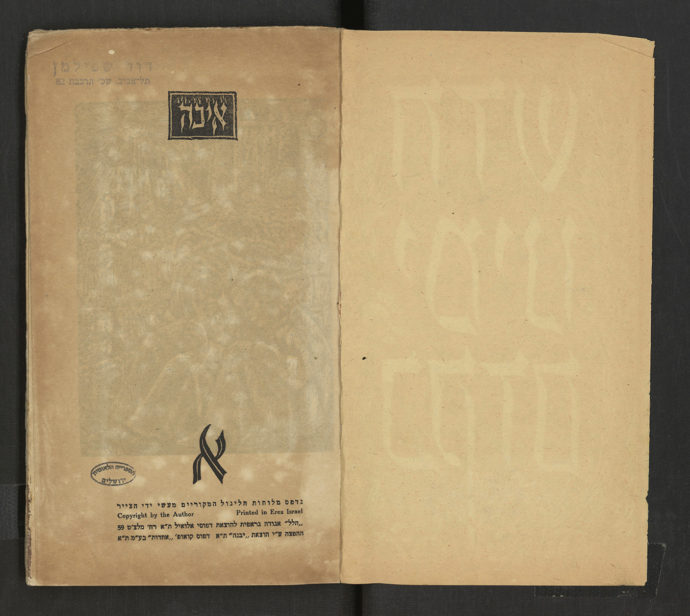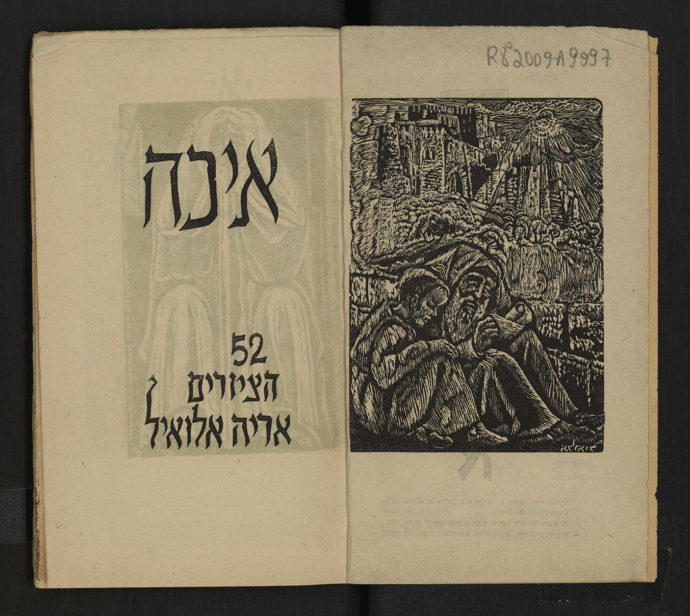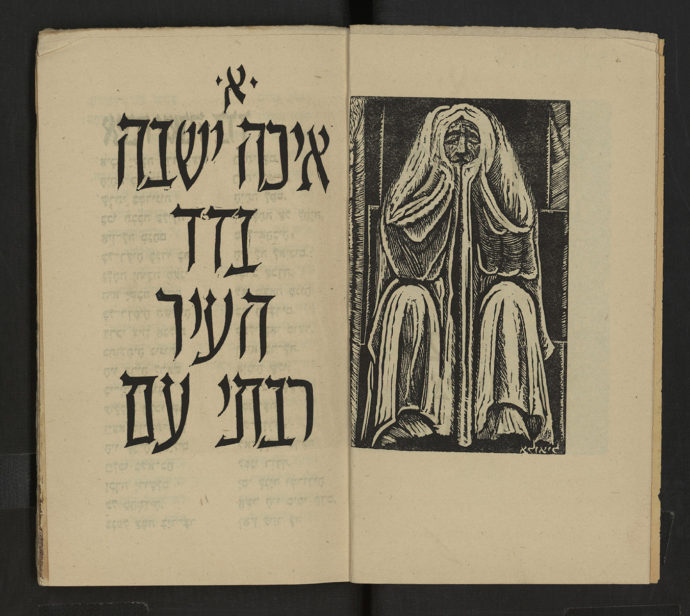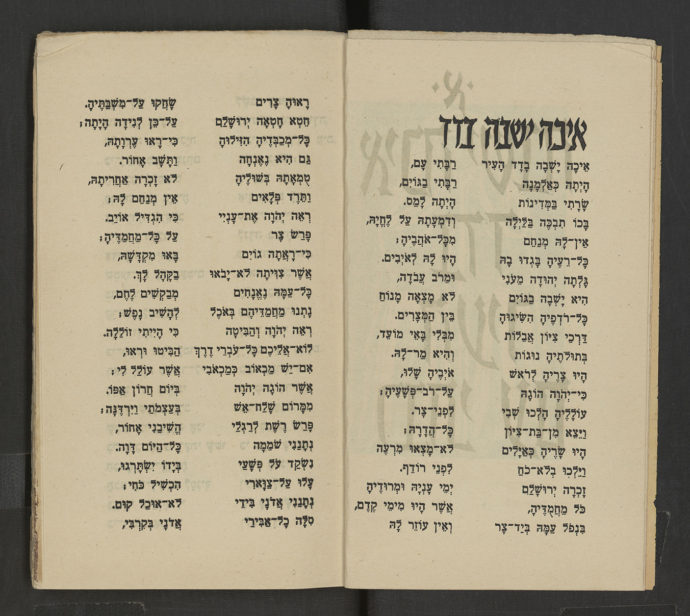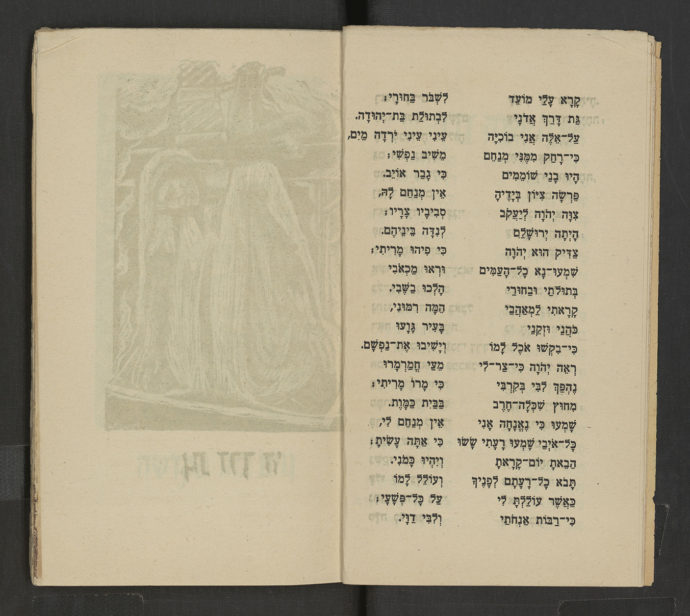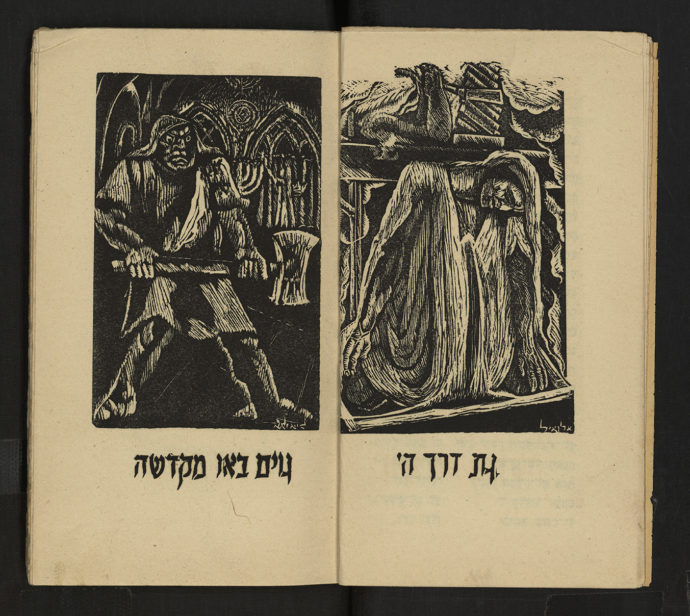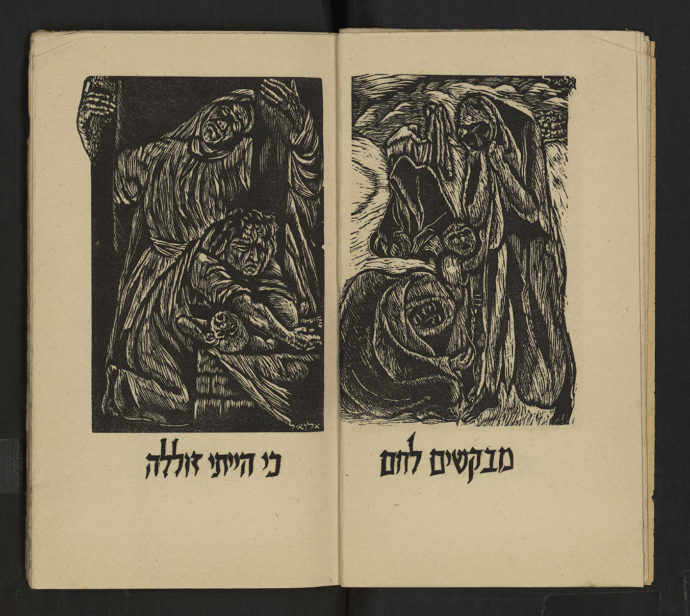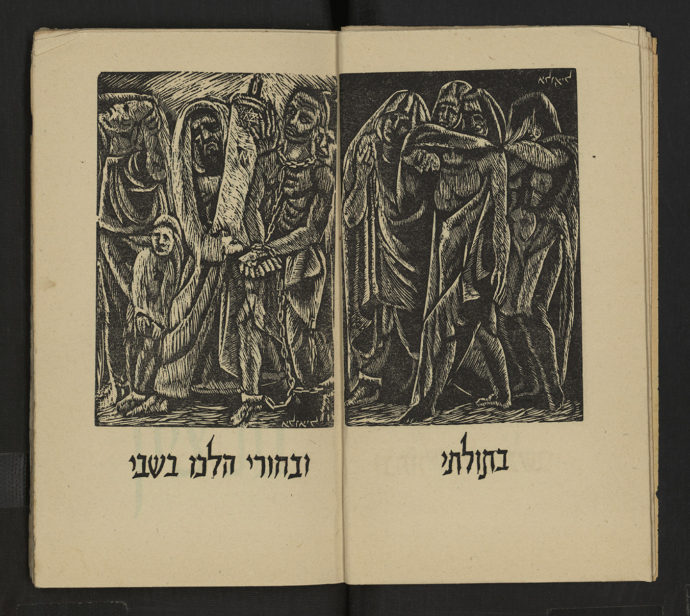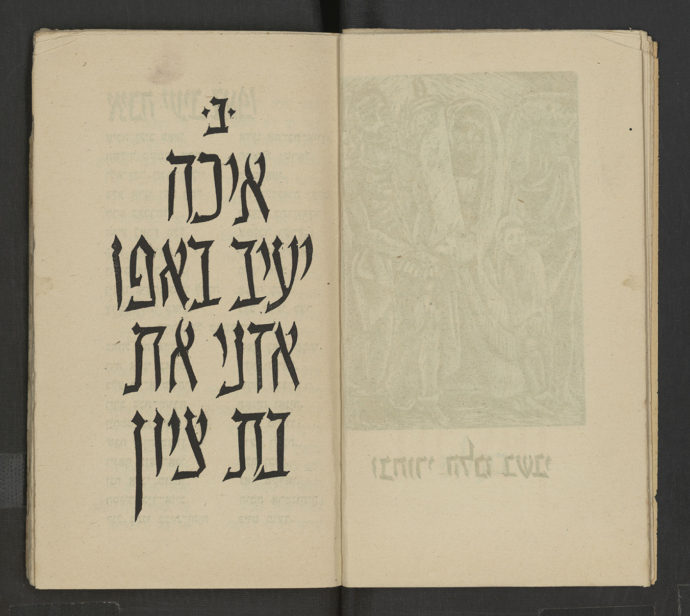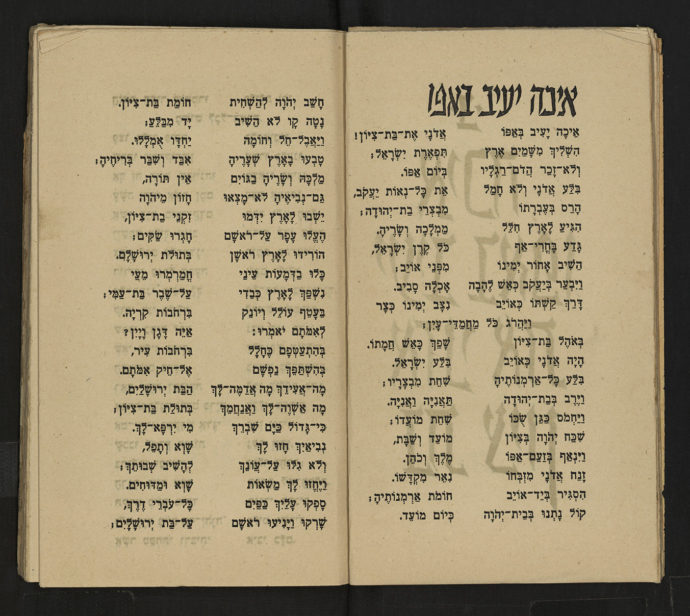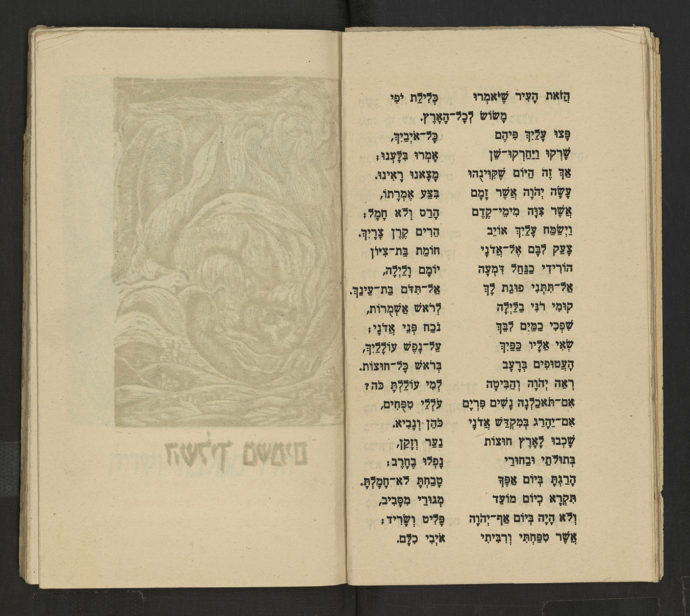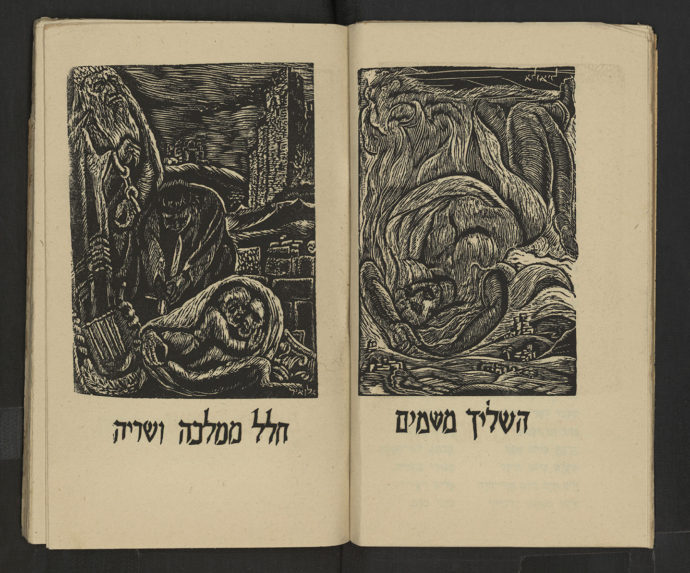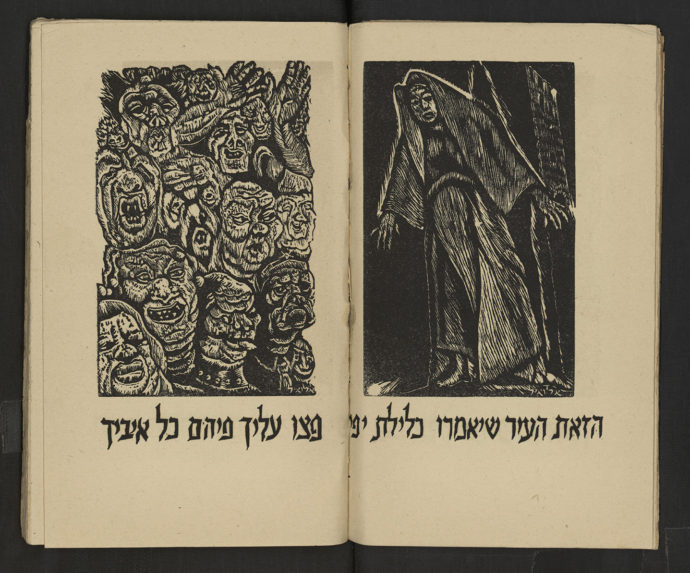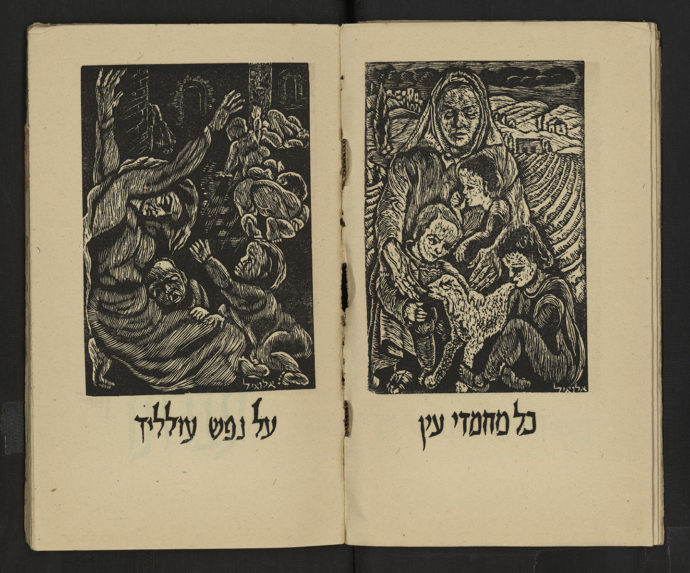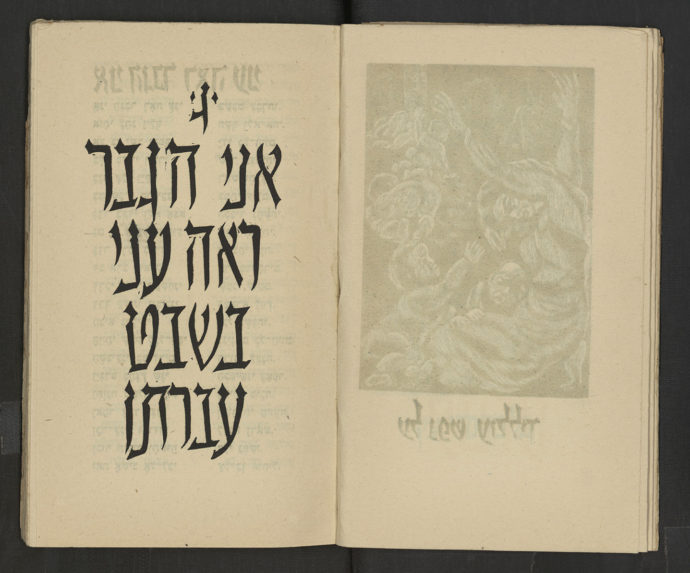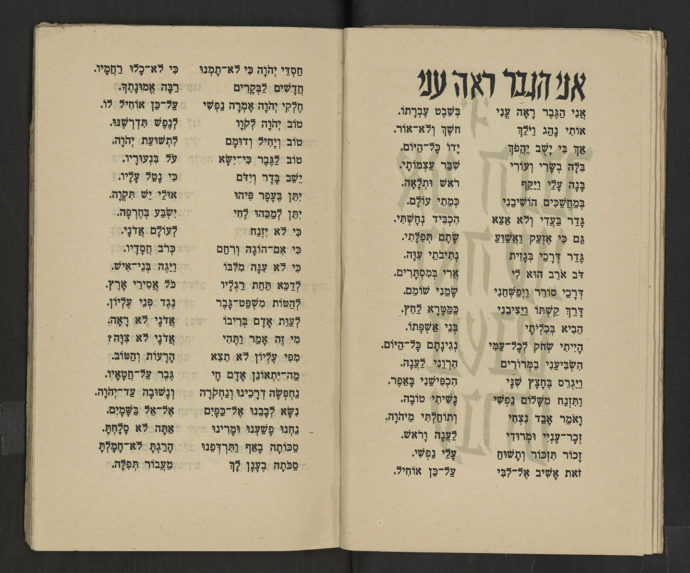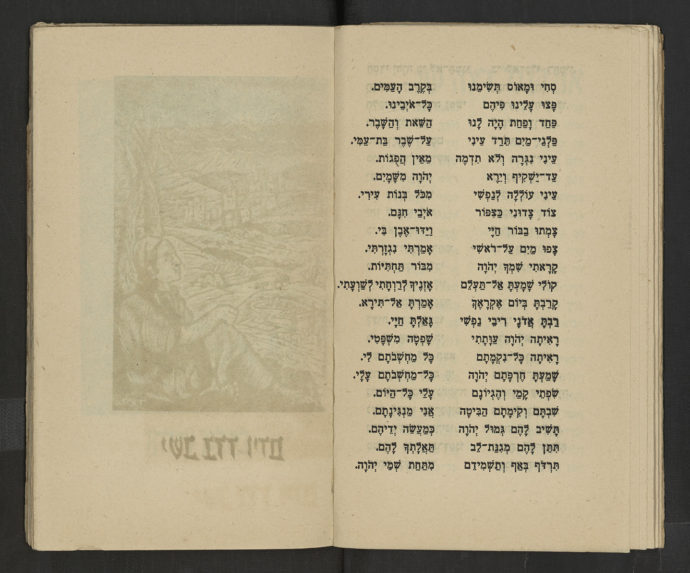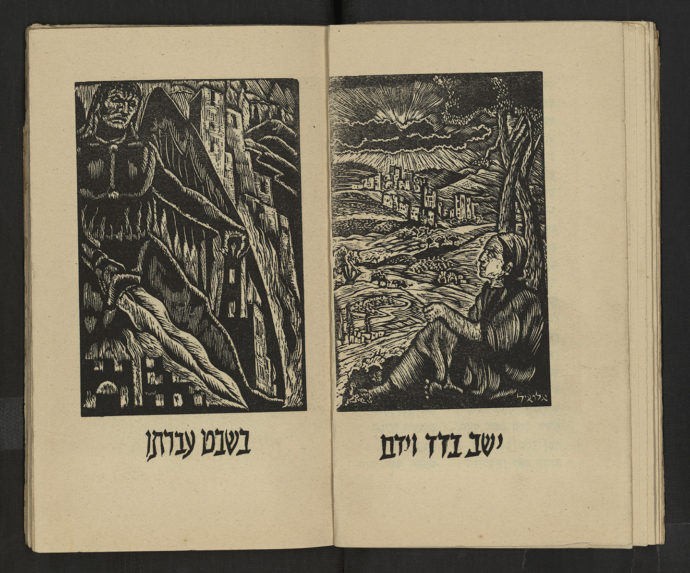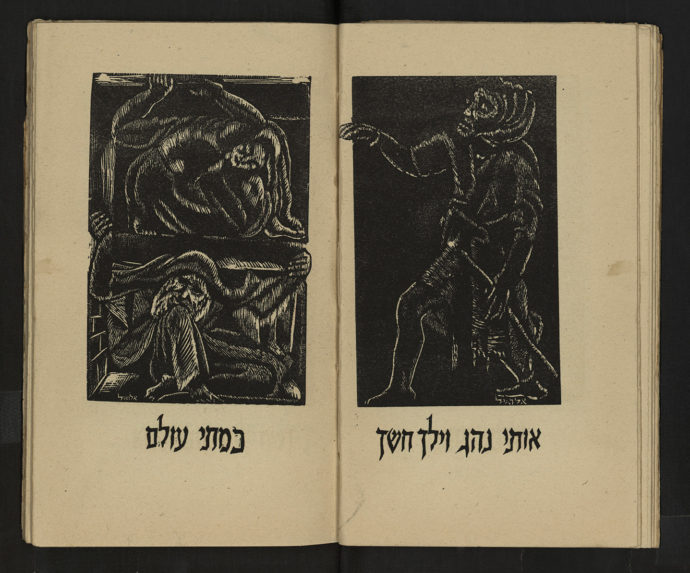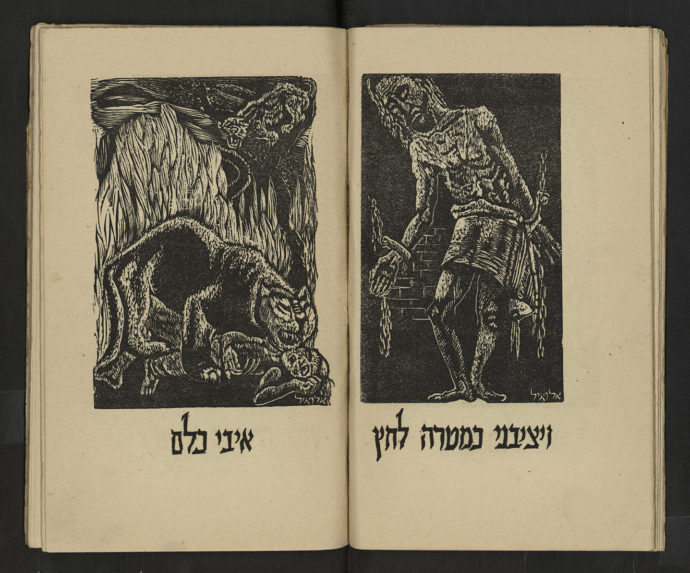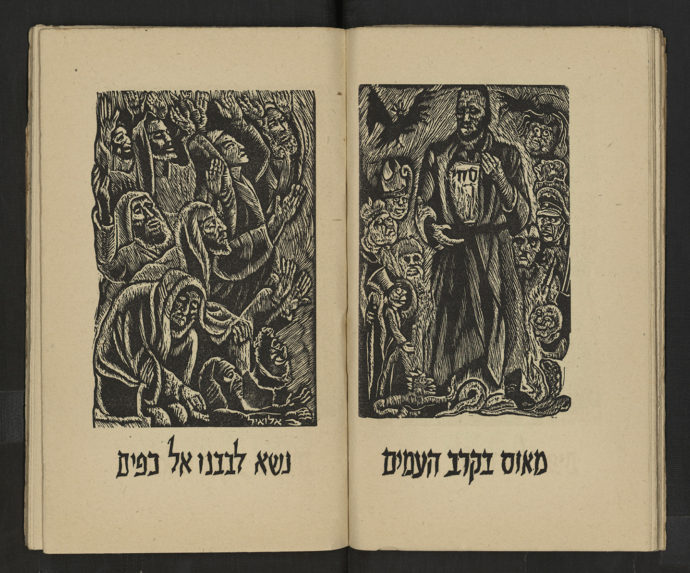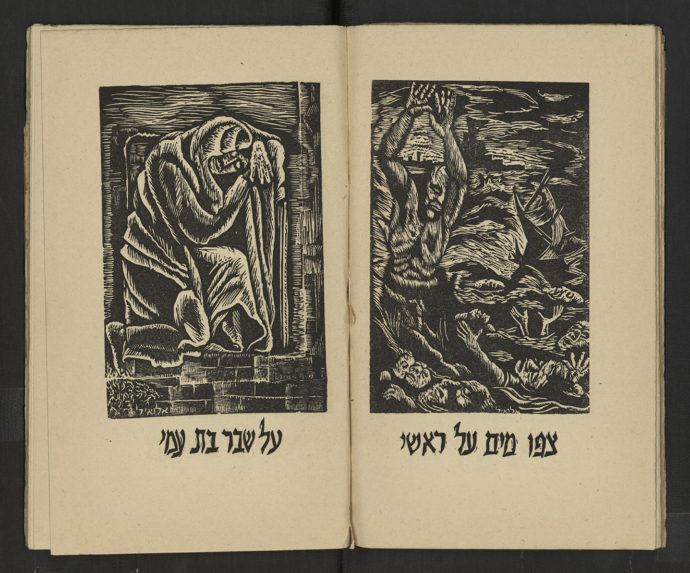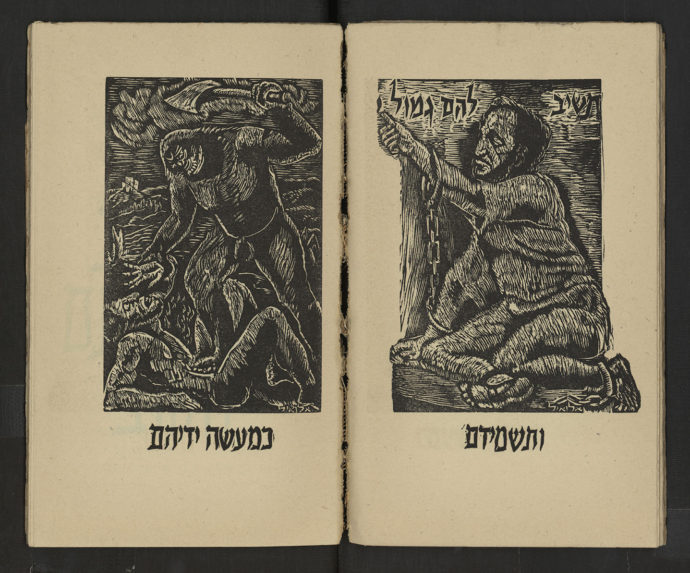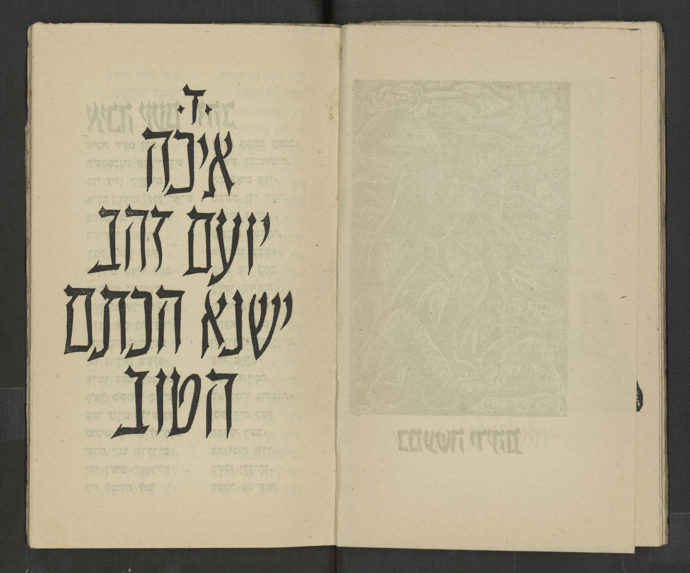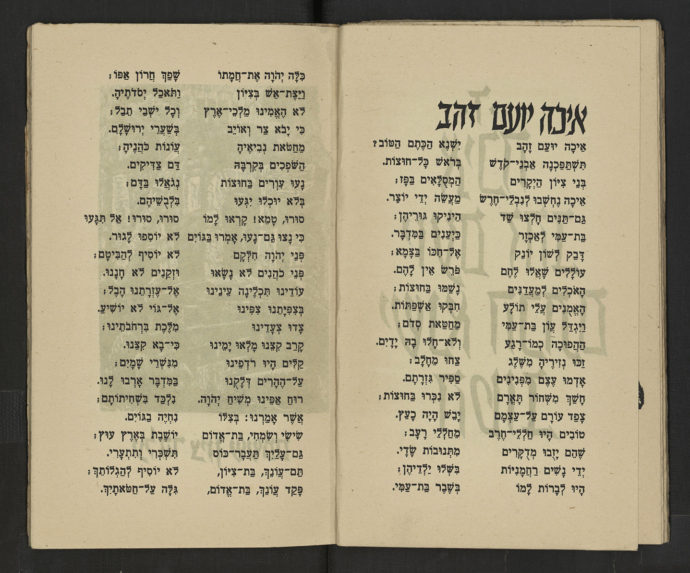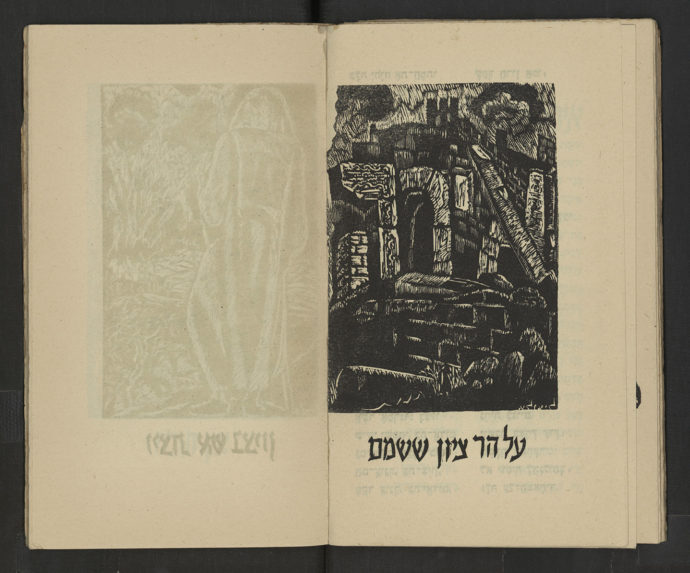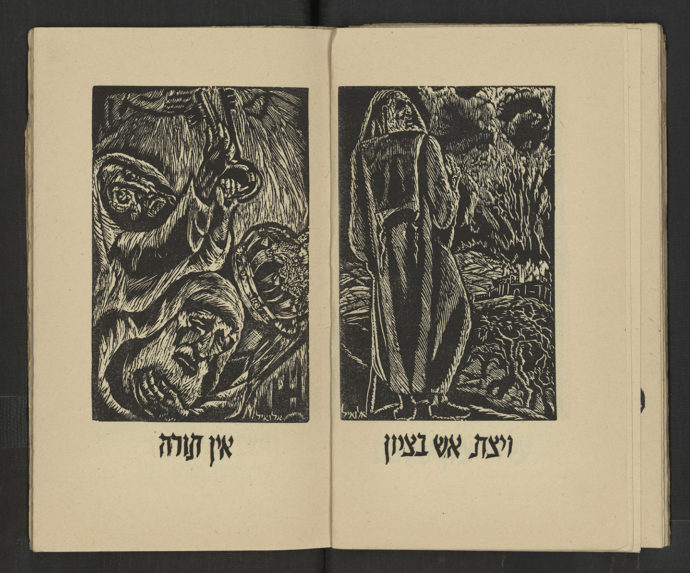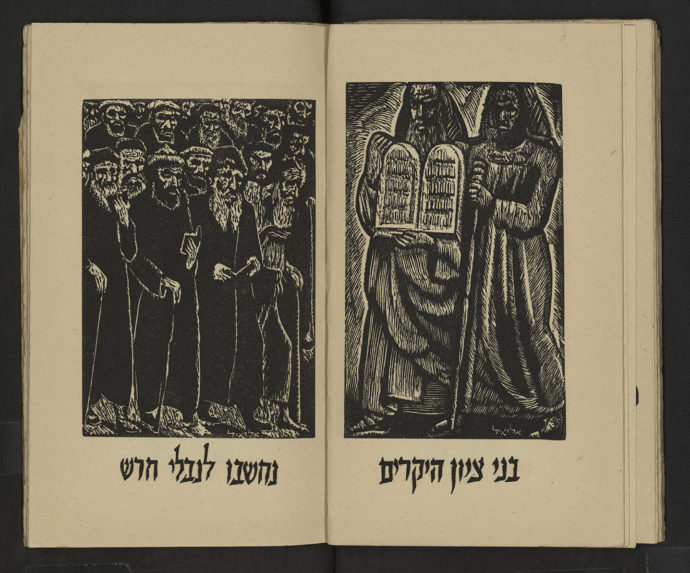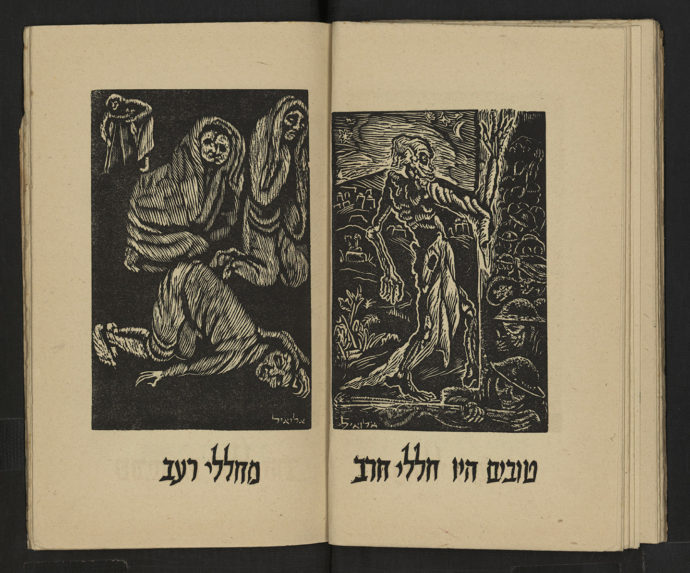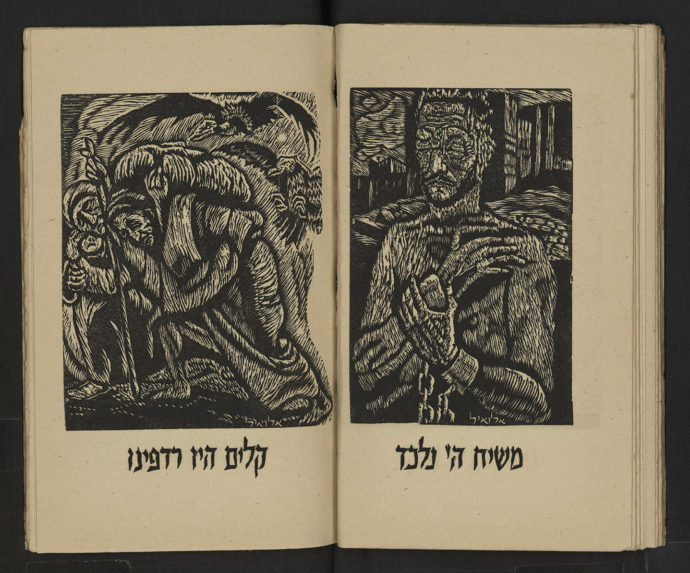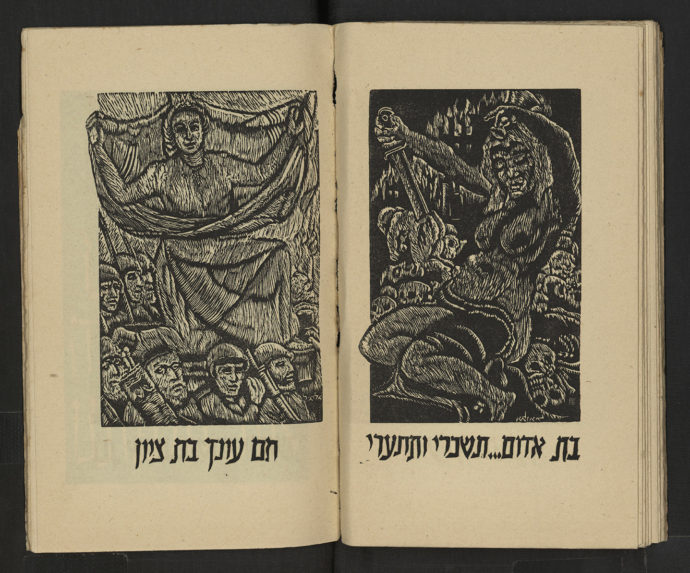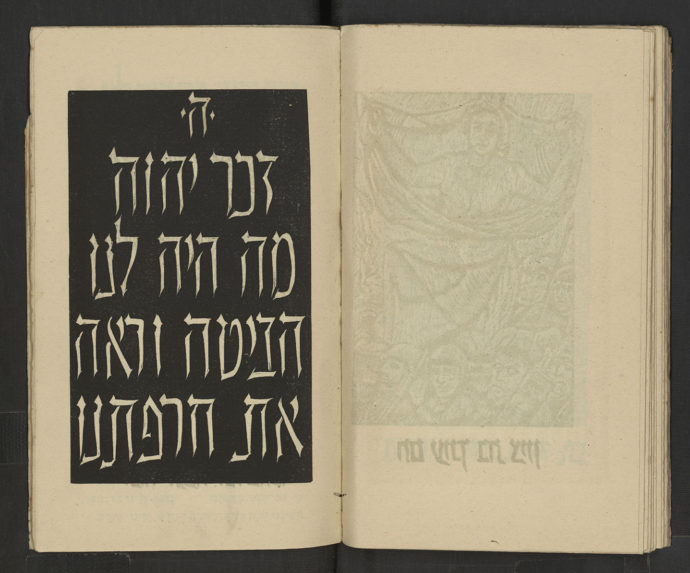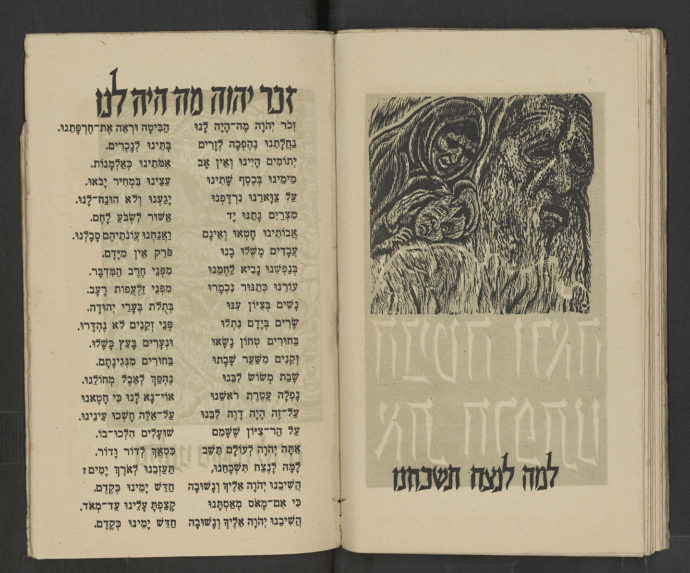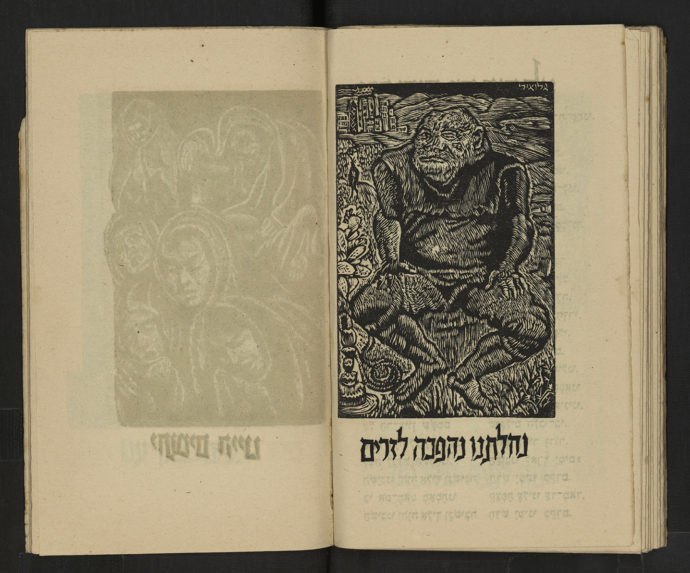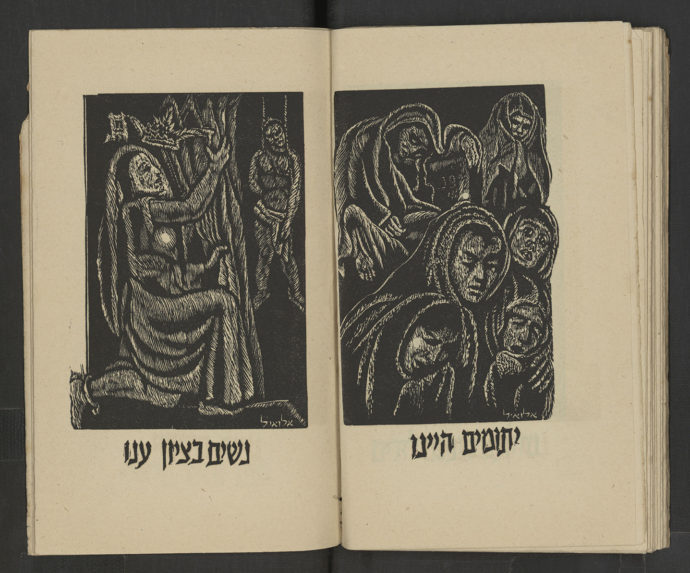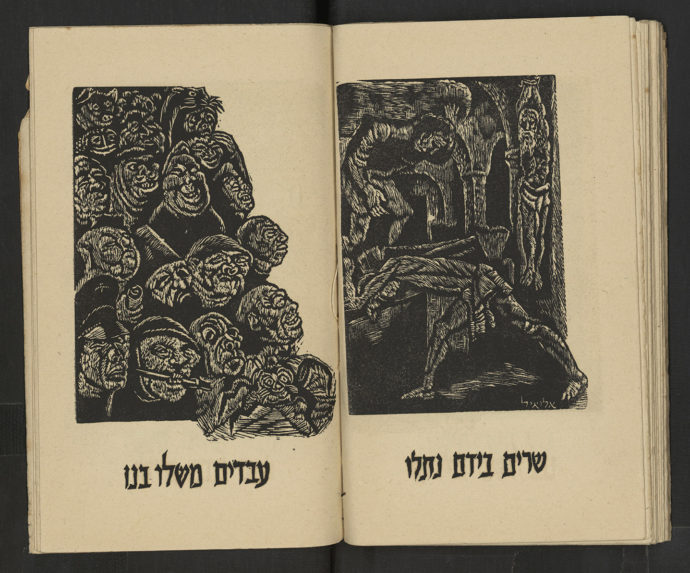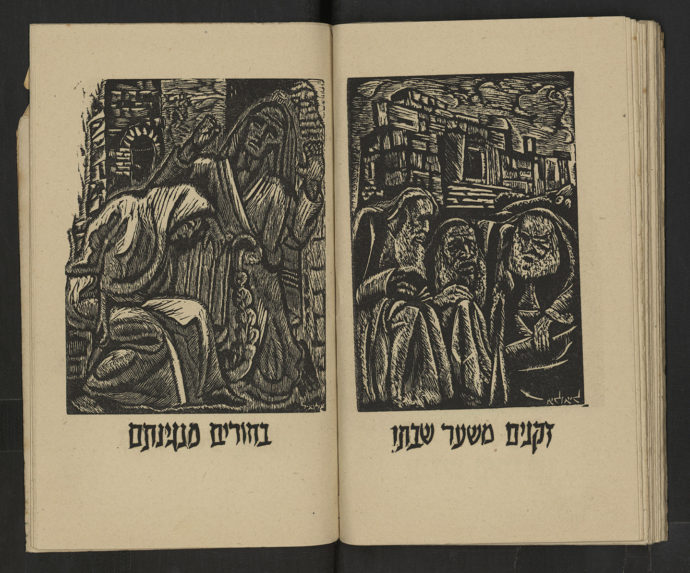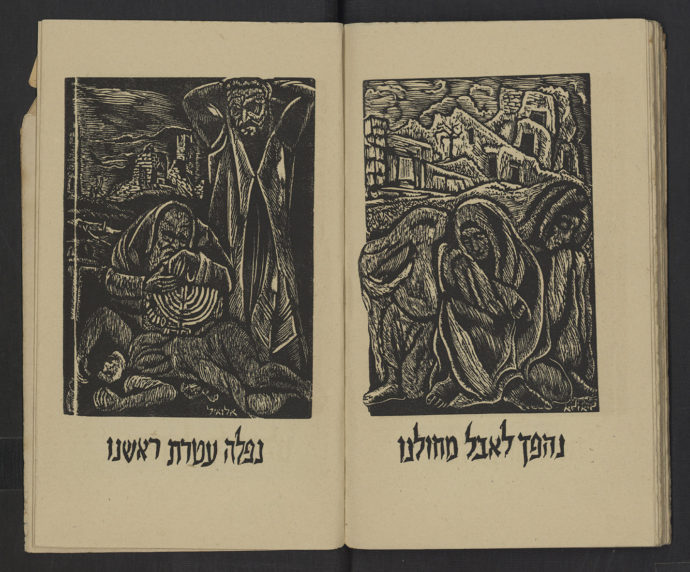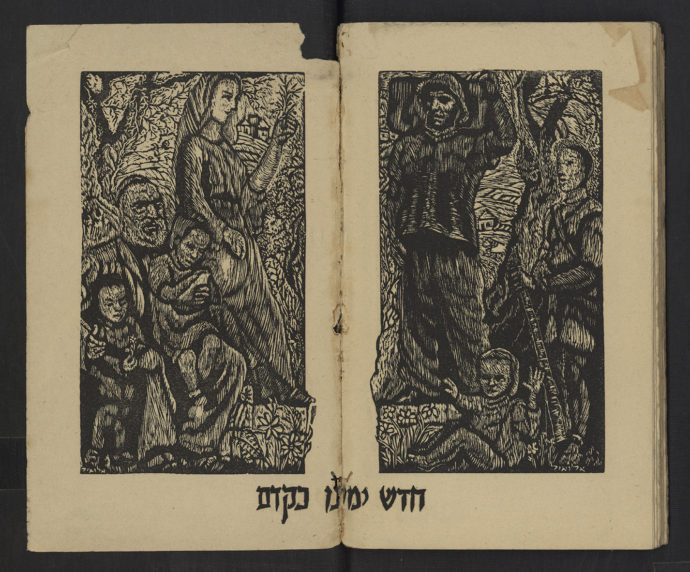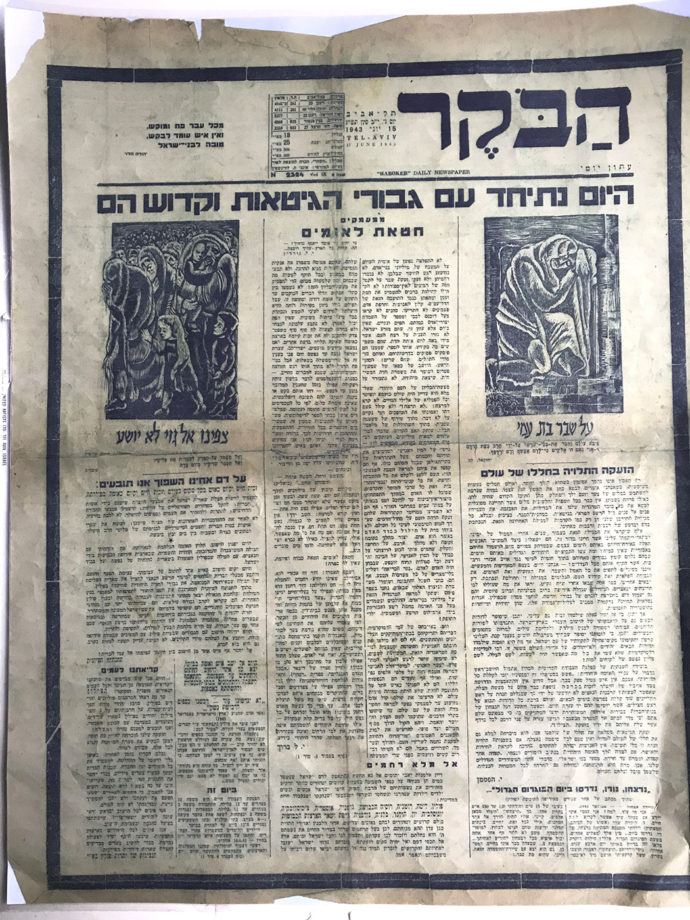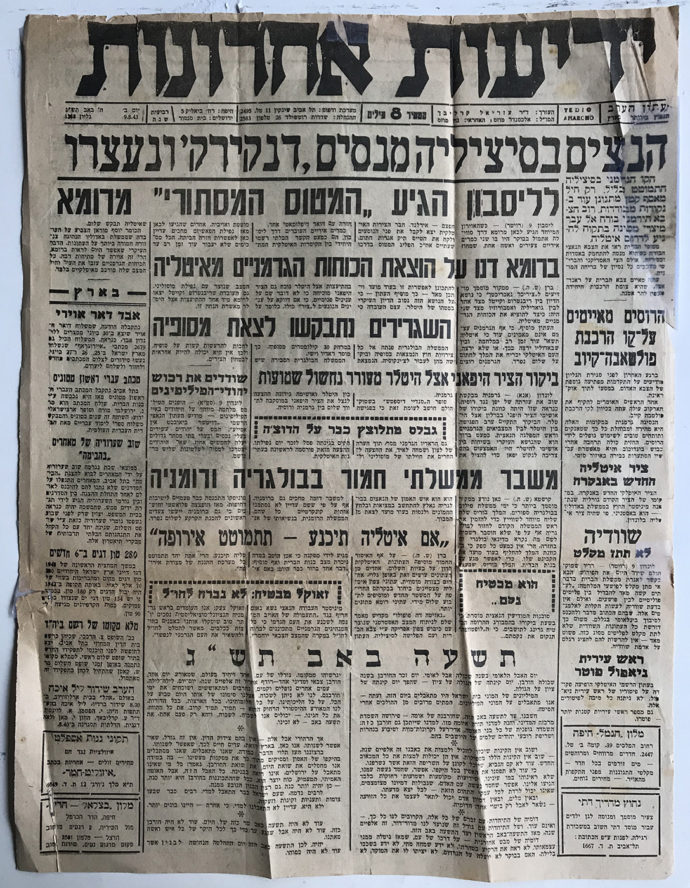Arieh Allweil’s Lamentation
INTRODUCTION
Lamentation is the fourth and last book that Arieh Allweil (1901-1967) made to illustrate Biblical megillahs (literally “scrolls”) with linocuts. The first was Ruth (1939); then Amos (1940), then Esther (1942), finally Lamentation (1943).
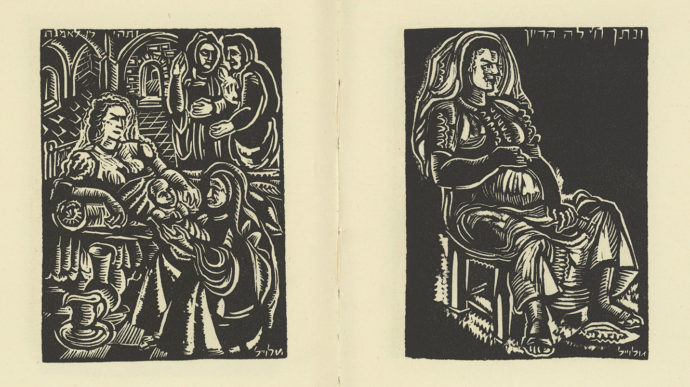
A page spread toward the end of Allweil’s “Scroll of Ruth.” Allweil wrote captions within the image. The one on the right reads: “And the Lord gave her conception.” And on the left: “And she became his nurse.”
Born in Galicia, then part of the Austro-Hungarian Empire, Allweil moved permanently to Eretz Israel (Mandatory Palestine) on 1926 after studying art in Vienna. When he worked on Ruth, his wife was pregnant with his first daughter, who would be named Ruth. His days as a father was about to begin, and he still was in contact with his parents in Galicia. The linocuts in Ruth had no hint of the dangers Jews were facing in Europe. Pastoral and familial imagery predominated. The cutting of the linoleum was broad and curvilinear.
His marking style changed dramatically with Amos. His created images with short jagged cuts. He also introduced into his Biblical tales anachronisms to reflect some of the horrors raging in Nazi-controlled Europe and the urgent need for self defense.
Yet, wrote his daughter Ruth Sperling in an email, “when he created Esther, he was still hoping that his family [in Galicia] survived and dedicated the book to his mother and father somewhere. When he created Lamentation, he already knew the disaster, both personal, all his family, and national, the millions of Jews that were massacred. In this book our father expresses his feeling and cry on the Holocaust at the time that it happened.”
In both Esther and Lamentation Allweil create a linocut with a dominant Moses figure juxtaposed with small non-Jewish imagery. In Esther, the images refer to other religions. In Lamentation, he shows faces of the Axis nations of World War II, including Hitler and Herman Goring in the middle right and a top-hatted Japanese Emperor Hirohito in the lower left. And Pope Pius XII also appears to be portrayed on the left.
For the first time in Lamentation, Allweil introduced an image of Death, the standing figure on the left with decrepit flesh and ragged clothing. In doing so he followed a long Northern European tradition of depicting Death. In response to years of plague, artists produced a series of images that were known as Dance of Death. In each case Death is shown leading away members from all strata of society, usually starting with the most exalted, i.e. the Pope, and ending with the lowliest. Illustrated here is a page from the 1744 book Todten Tans from the City of Basle with etchings by Matthieu Merian.
Lamentation was an appropriate choice for Allweil considering the ongoing horrors in Europe. From the online website biblescripture.net: “The Book of Lamentations is a reflection by the Prophet Jeremiah on the destruction of Jerusalem and the Temple in 586 BC, with the subsequent Babylonian Exile. The Book contains five poems of 22 verses each, except for Chapter 3 which contains 66 verses…. While the poetry expressed pain and sorrow over the loss of Jerusalem, there is also an acceptance of punishment for the sins of Israel in their disregard for the way of the Lord. Finally there is an expression of hope that God will one day provide deliverance from their chastisement.”
However, Sperling wrote that looking through Allweil’s Lamentation linocuts she could not find one image related to “punishment for the sins of Israel” as stated in the biblescripture.net quote. Rather, she emailed, his book “is a huge and long cry over what happened in the Holocaust.”
Allweil’s Lamentation does indeed conclude with images of hope. Here the caption reads: “Turn us unto thee O Lord, and we shall be turned.” This and the following two-page spread are the only ones that share a caption. While there are other two-page spreads in Lamentation that suggest a single, unified image, in his final two spreads the continuity of an image is most evident.
In his autobiographical remarks that appears in the book Allweil (Arieh Allweil, Max Brod & I.M. Lask, “Sinai” publishing, Tel Aviv, Israel, 1956), Allweil wrote that the following was his motto for his book Amos: “The prophet spoke to all generations, and to our generation… and in that spirit, the painter painted his pictures.” (He applied his motto, Sperling writes, to all of his Biblical books.) He added: “I similarly made three Megillahs: Ruth, Esther and Lamentations. I put the figures into our home, the people are our brothers, our parents and our children…..The book Lamentations is in our time.”
* * *
This is the ninth ART I SEE blog post on the works of Arieh Allweil. Links to the other eight conclude this post. None of these posts would have been possible without the tireless help and ceaseless support of the artist’s two daughters: Ruth Sperling, Professor of Genetics at the Hebrew University of Jerusalem, and Nava Rosenfeld, a retired architect.
Lamentation and its contents as well as preparatory drawings and calligraphy are presented courtesy of the Estate of Arieh Allweil.
Production of Lamentation
Arieh Allweil cut all of the images for his Lamentation on linoleum blocks. He also used linoleum blocks when he wanted to use large Hebrew letters.
Above are two views of one of his linocuts. The image on the right shows that for production purposes, the linoleum blocks were mounted on wood.
For the endpapers (inside the front and back covers) Allweil cut the letters and imagery on the same blocks.
Examples of Allweil cutting text in linoleum blocks are found at the start of Lamentation‘s five chapters. On the right begins Chapter A; on the left Chapter E. The latter is an instance where Allweil recreated white letters on a black background.
For the body of the text in Lamentation, Allwweil turned to mechanically printed Hebrew via Linotype machines. The text page on the left is from Lamentation. Note that there is clear separation vertically between lines and that the lines are not justified, i.e. ragged left. The text page on the right is from his Scroll of Esther. For Esther he hand printed the letters with pen and ink. In Allweil’s calligraphy letter ascenders and descenders took up more than one line, and his letters were much more compact. He also justified each line. For Esther, Allweil had text pages photographed and turned into electrotypes.
Asked why her father chose to use mechanical type in Lamentation, Sperling wrote: “I don’t know why, but I can guess that the pain and shock were so enormous, and it was burning within him to express the pain right away, and not wait for the lengthy writing of the whole text.”
Allweil did preparatory drawings in chalk and ink before he cut into the linoleum. Nava Rosenfeld kindly provided a couple dozen images of these drawings. Below I paired almost half of them with the finished Lamentation linocuts. They are presented in the sequence in which they appear in the book.
The drawing here is on translucent pergament paper, which he used when he was satisfied with the drawing and was ready to transfer it onto the linoleum block.
Lamentation: the complete book
The Cover
LAMENTATION
Painting by Arieh Allweil
Endpapers
RIGHT: Turn thou us into thee and we shall be turned
LEFT: Renew our days as of old (Lamentations 5/21)
LAMENTATION (small linocut)
Printed from the original plates made by the artist
Copyright by the author. Printed in Eretz Israel.
“Hillel” Graphique Society to print Allweil’s prints. Tel Aviv 59 Melchet St.
Distributed by “Yayneh” Publishers Tel Aviv Co-op “AHDUT” Ltd. Tel Aviv
LAMENTATION
52 paintings Arieh Allweil
Chapter A
How doth the city sit solitaire that was full of people (Lamentation A/1)
RIGHT: The Lord has trodden the virgin, the daughter of Judah as in a wine press
LEFT: The heathen entered into her sanctuary (both Lamentation A/18)
RIGHT: They seek bread (Lamentation A/15)
LEFT: For I become vile (Lamentation A/10)
RIGHT: My virgin
LEFT: And my young men are gone into captivity (both Lamentation A/18)
Chapter B
How has the Lord covered the daughter of Zion with a cloud, in his anger (Lamentation B/1)
RIGHT: And cast down from heaven unto the Earth (Lamentation B/1)
LEFT: He has brought her kingdom and its princes down to the ground in dishonor (Lamentation B/2)
RIGHT: Is this the city that men call the perfection of beauty (Lamentation B/15)
LEFT: All thine enemies have opened the mouth against thee (Lamentation B/16)
RIGHT: All that were pleasant to the eye (Lamentation B/4)
LEFT: For the life of thy young children (Lamentation B/19)
Chapter C
I am the man that has seen affliction by the rod of his wrath (Lamentation C/1)
RIGHT: Has sat alone and kept silence (Lamentation C/28)
LEFT: By the rod of his wrath (Lamentation C/1)
RIGHT: He has led me and brought me into darkness (Lamentation C/2)
LEFT: As they that be dead of old (Lamentation C/6)
RIGHT: Set me as a mark for the arrow (Lamentation C/12)
RIGHT: All my enemies (free translation)
RIGHT: Scum and refuse among the nations (Lamentation C/45)
LEFT: Let us lift our heart with our hands unto God in the heavens (Lamentation C/41)
Asked about the significance of the word “סחי” showing within the standing figure on the right, Nava Rosenfeld said: “The word “סחי” that is written on his chest means ‘Scum.’ In the King James Bible it says: ‘Thou had made us as the offscouring and refuse in the middle of people.’ In the New Bible it says: ‘You have made us scum and refuse among the nations.’ ”
RIGHT: Water flowed over my head (Lamentation C/54)
LEFT: For the destruction of the daughter of my people (Lamentation C/48)
RIGHT: Destroy them… (Lamentation C/66)
LEFT: …according to the works of their hands (Lamentation C/65)
Rosenfeld also commented on the lettering above the figure on the right: “On this linocut Allweil wrote from Lamentation C/64. In The New Bible version it says: ‘PAY THEM BACK what they deserve, Lord, for what they have done.’ In the King James Bible it says; ‘Render unto them a recompense, O Lord, according to the work of their hands.’ ”
Chapter D
How has the gold become dim! How is the most fine gold changed! (Lamentation D/1)
Because of mountains of Zion which is desolate (Lamentation E/18)
RIGHT: Has kindled a fire in Zion (Lamentation D/11)
LEFT: The law is no more (Lamentation B/9)
RIGHT: The precious sons of Zion (Lamentation D/2)
LEFT: How are they esteemed as earthen pitchers (Lamentation D/2)
RIGHT: When they fled away and wandered (Lamentation D/15)
LEFT: We have watched for a nation that could not save us (Lamentation D/9)
RIGHT: They that be slain with the sword are better… (Lamentation D/9)
LEFT: …than they that be slain with hunger (Lamentation D/9)
RIGHT: The anointed of the Lord was taken unto the pits (Lamentation D/20)
LEFT: Our persecutors are swifter (Lamentation D/19)
RIGHT: O daughter of Edom…thou shalt be drunken and shalt make thy self naked (Lamentation D/21)
LEFT: The punishment of thine iniquity is accomplished, O daughter of Zion (Lamentation D/22)
CHAPTER E
Remember O Lord what is come upon us. Consider and behold our reproach (Lamentation E/1)
RIGHT: Wherefore doest the forget us forever (Lamentation E/20)
Our inheritance is turned to strangers (Lamentation E/2)
RIGHT: We are orphans (Lamentation E/3)
LEFT: They ravished the women of Zion (Lamentation E/11)
RIGHT: Princes are hanged up by their hands (Lamentation E/12)
LEFT: Servants have rules over us (Lamentation E/8)
RIGHT: The elders have ceased from the gate (Lamentation E/14)
LEFT: The young men from their music (Lamentation E/14)
RIGHT: Our dance is turned into mourning (Lamentation E/15)
LEFT: The crown is fallen from our head (Lamentation E/16)
Turn us unto thee O Lord, and we shall be turned (Lamentation E/21)
Renew our days as of old (Lamentation E/21)
Endpapers repeated
Epilog
Linocuts from Arieh Allweil’s Lamentation appeared in newspapers in Eretz Israel to accompany reports of the dire situation in Europe in 1943. His daughters Ruth Sperling and Nava Rosenfeld provided the following images and translations.
Haboker newspaper dated 15 June 1943.
Headline reads: “Today we commune [cry] wit the Heroes of the Ghettoes and their martyrs”
Yediot Aharonot (Last News) newspaper dated 9 August 1943
Main headline reads: “The Nazies in Sicily try Dunkirk and stopped”
Opposite side of Yediot Aharonot sheet
Main headline reads: “On this night my sons cry; the night my house was destroyed, and my palaces were burnt”
PREVIOUS POSTS ON ARIEH ALLWEIL
This post is the ninth on the works of Arieh Allweil. Here are links to the previous eight.
- The first introduced the artist and offered a snapshot of his books (LINK).
- The second was the first of two posts devoted to Allweil’s Book of Amos. It examined his production of text in linoleum cuts. (LINK)
- The third presented all of the linocuts in Amos with translations of captions and much of the text. (LINK)
- The fourth stepped back to his days in Vienna, where he created a portfolio of lithograph entitled Graues Band in German and Tura Afura in Hebrew. (LINK)
- The fifth present his book Anonymous Jew and a translation of the essay by Max Brod. (LINK)
- The sixth covered the book of linocuts called Touring the Land and a translation of its essay by Max Brod. (LINK)
- The seventh covered the 1939 Scroll of Ruth. (LINK)
- The eighth covered the 1942 Scroll of Esther (LINK)
Trackback URL: https://www.scottponemone.com/arieh-allweils-lamentation/trackback/

